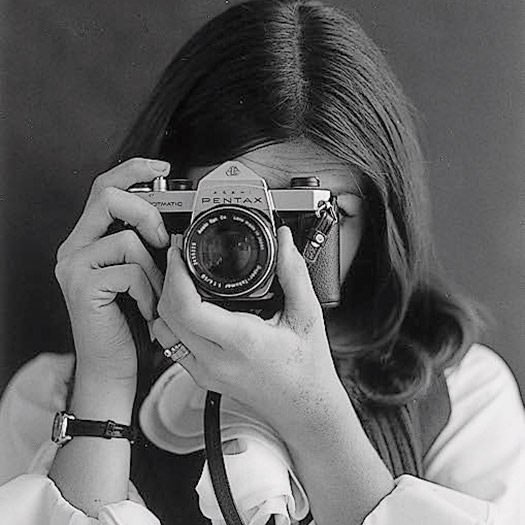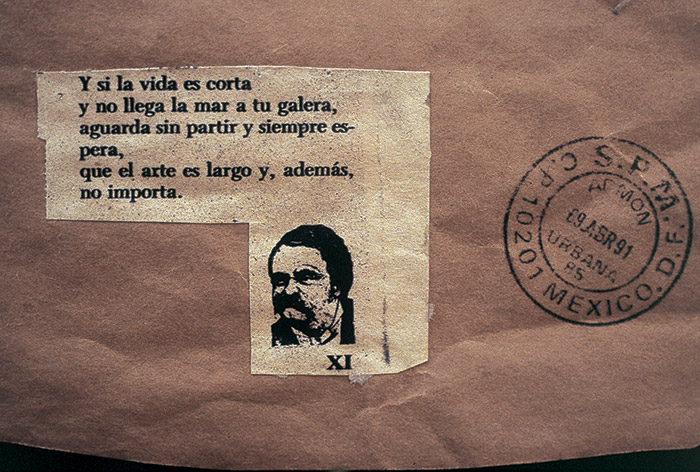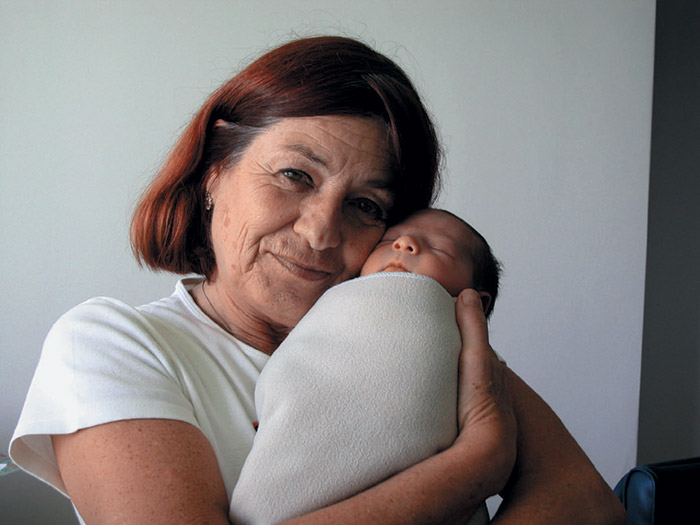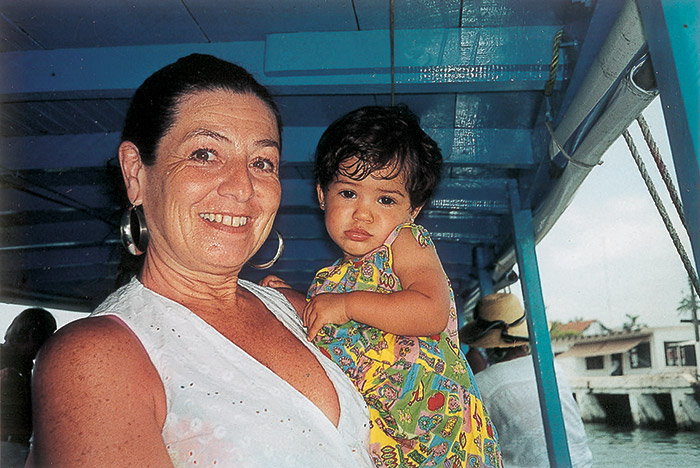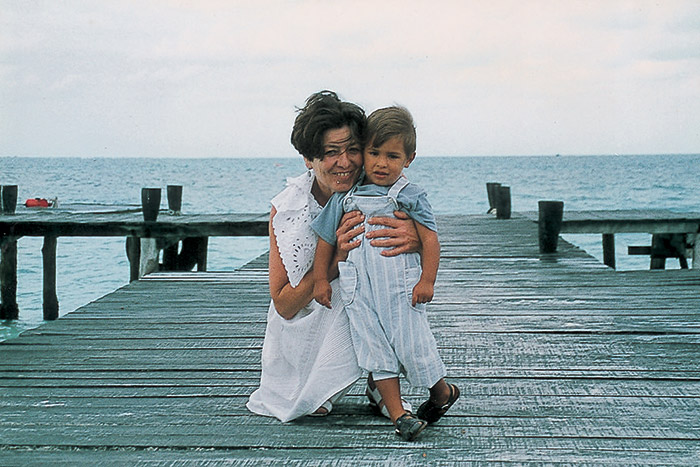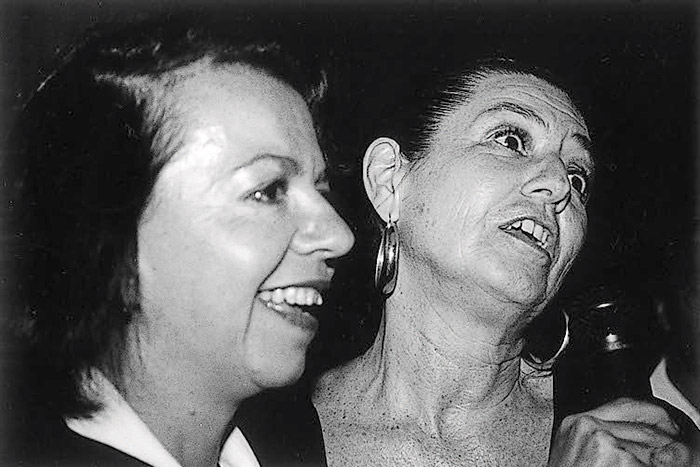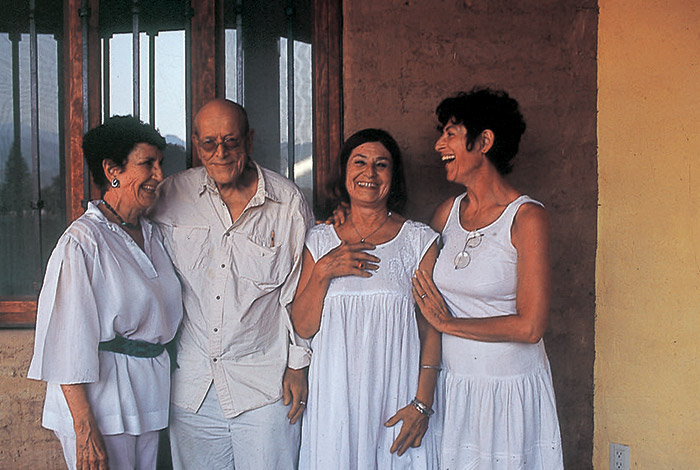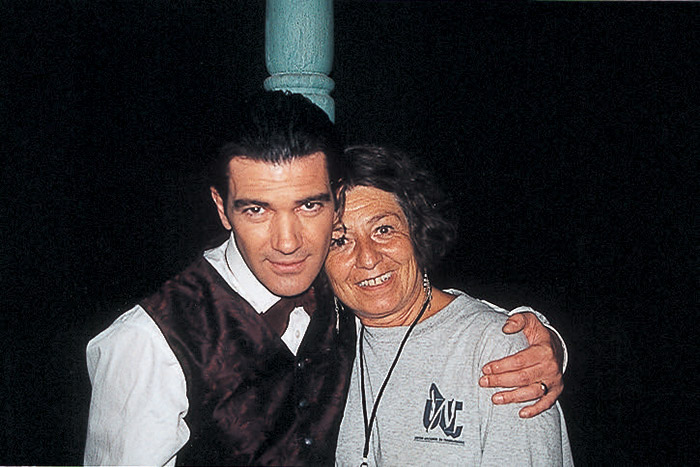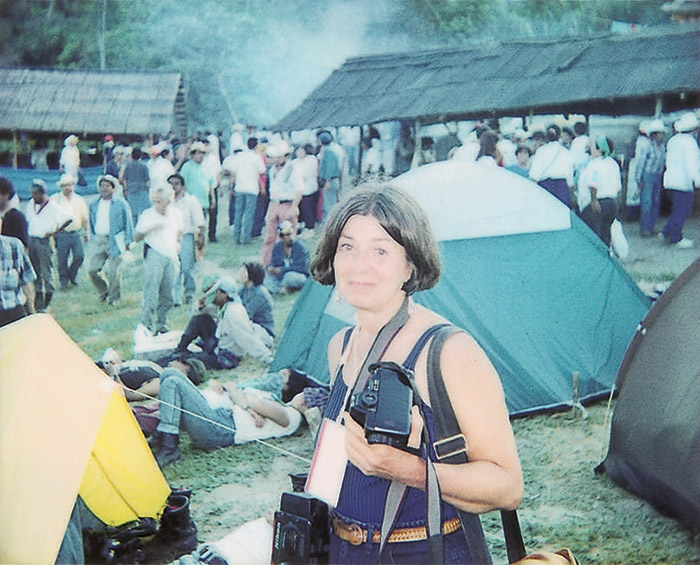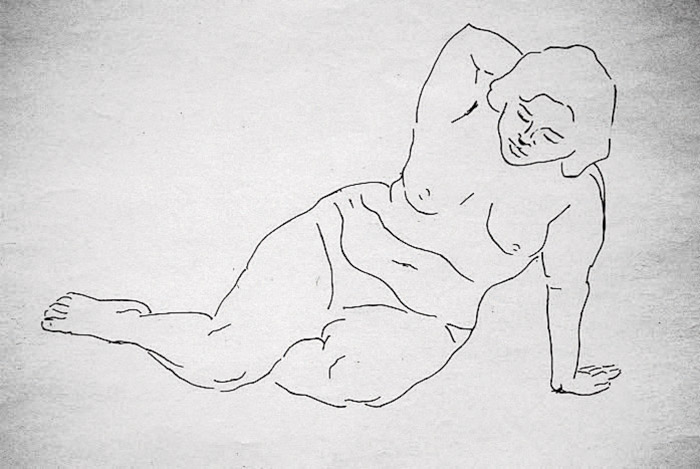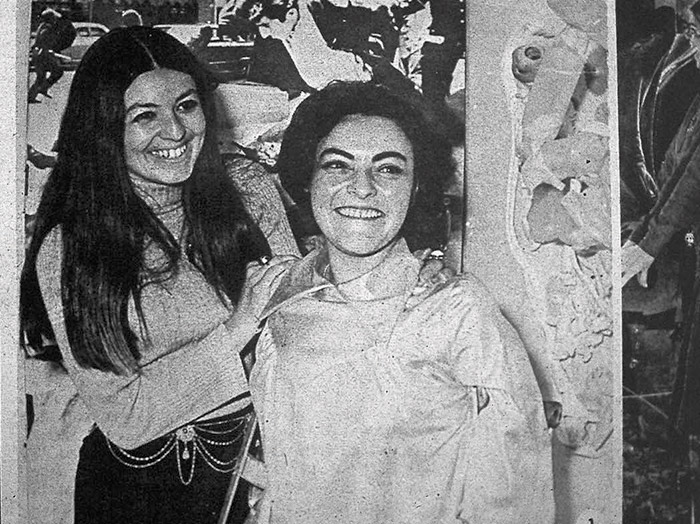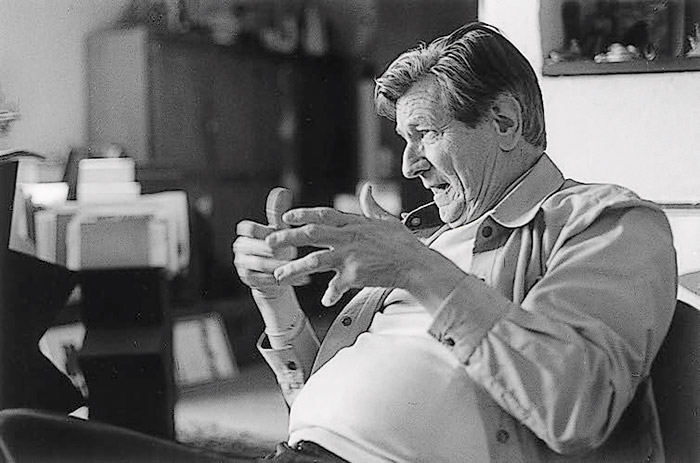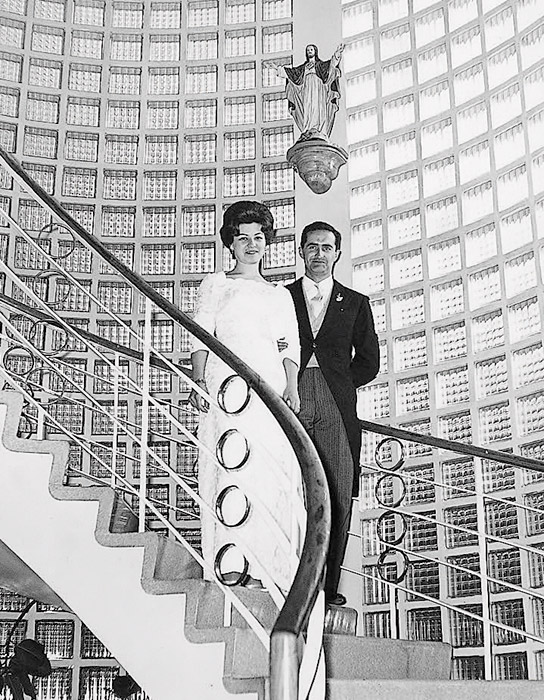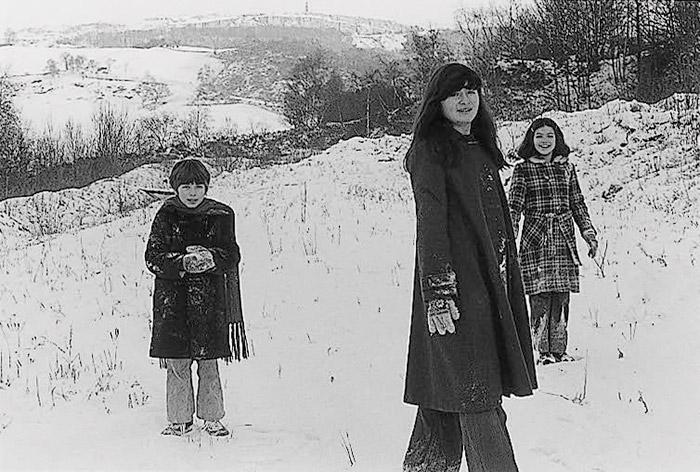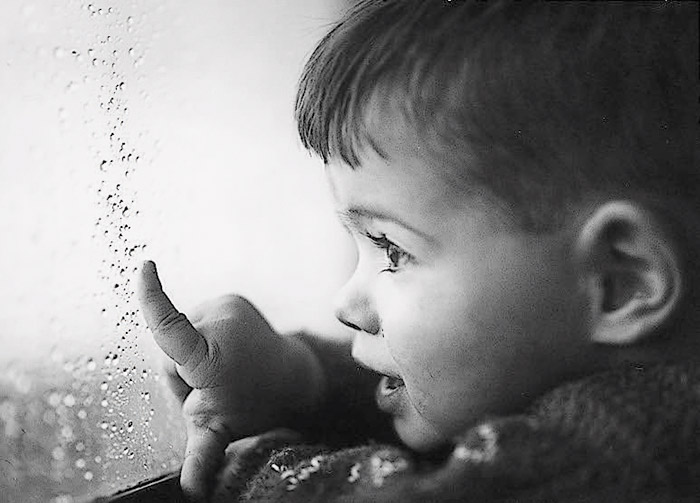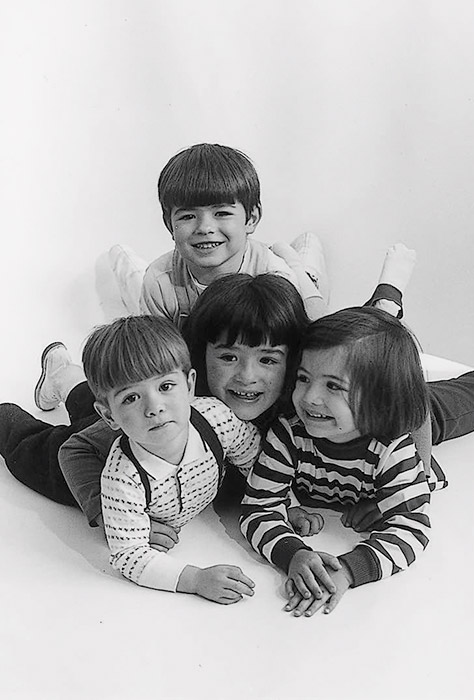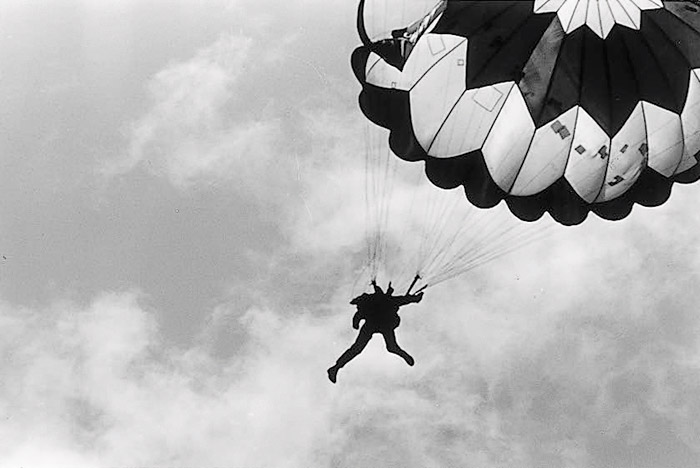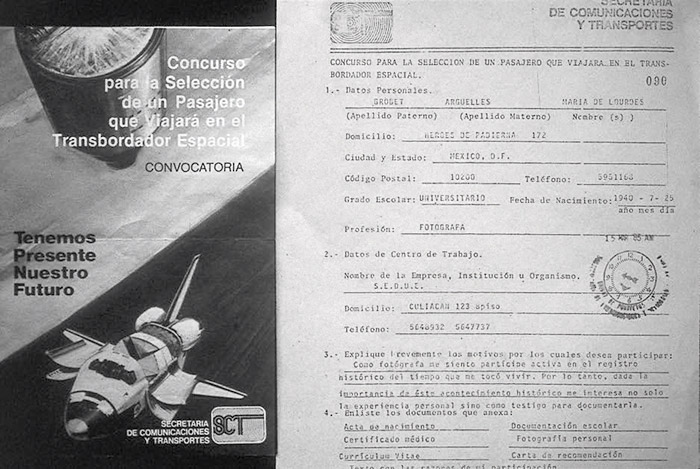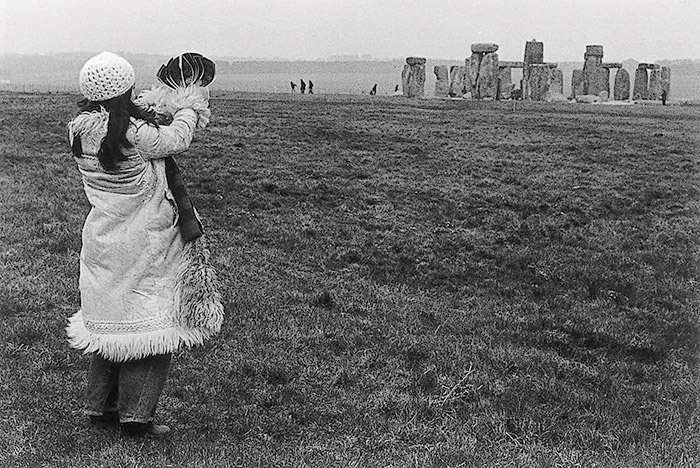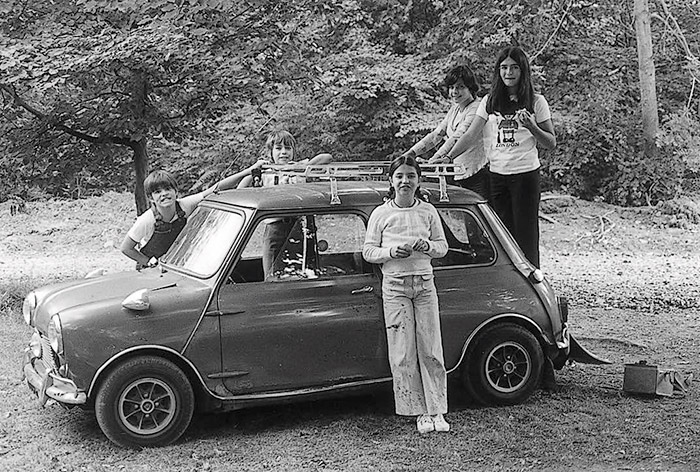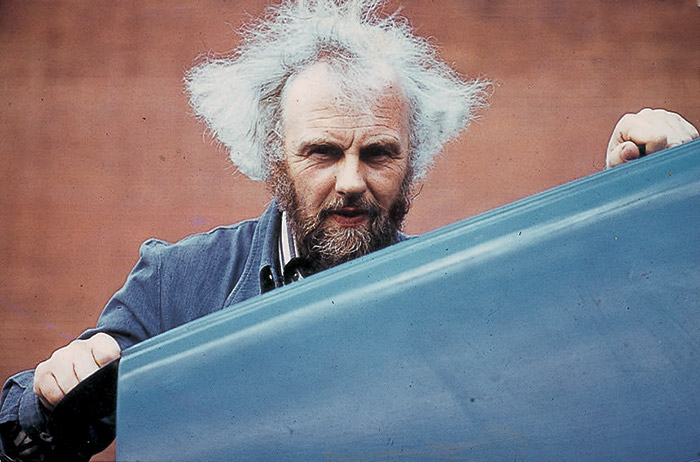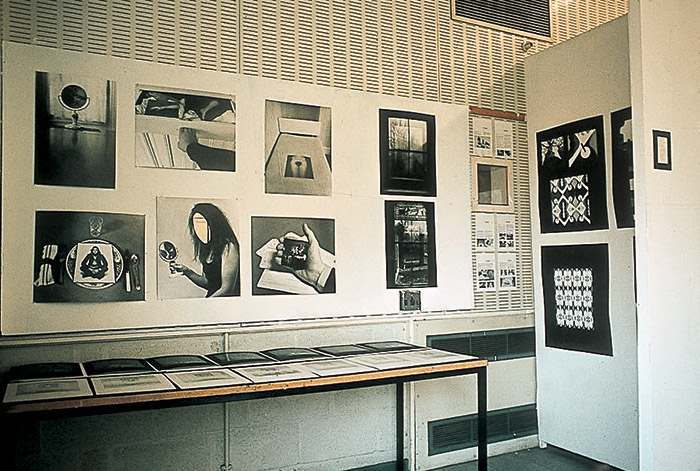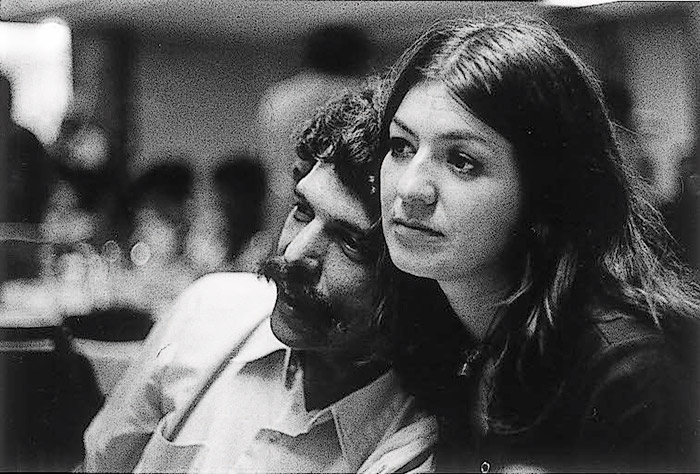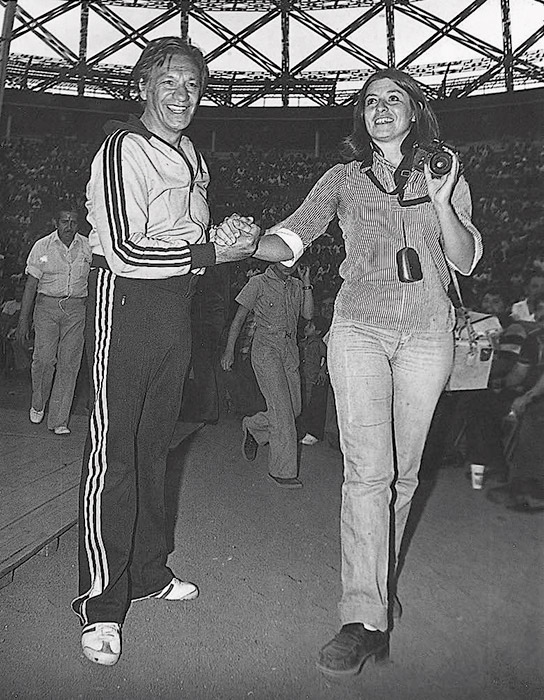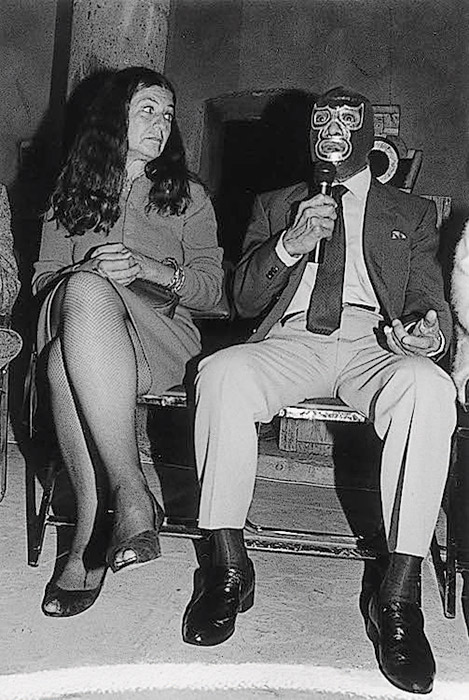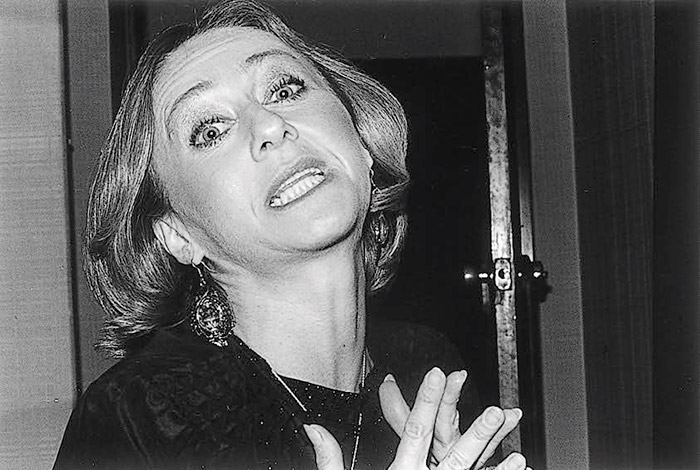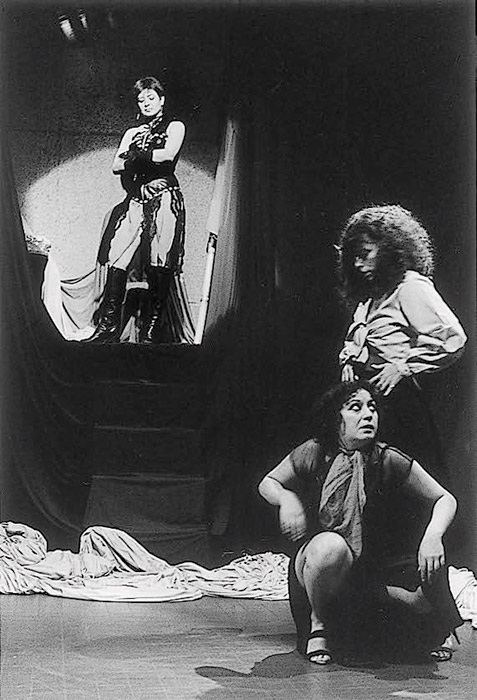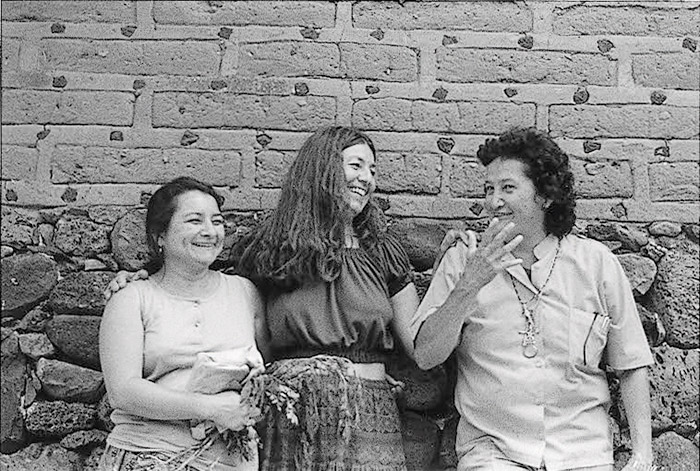Lourdes Grobet. Photography and Environment.
Víctor Muñoz
 Due as much to Lourdes Grobet's schooling as to the period's critical sense, the origins of her art practice are closely tied to contemporary painting. She was a student of artists Mathias Goeritz, Gilberto Aceves Navarro and Katy Horna, among others. "The teachers that most influenced me early on," says Grobet, "were Mathias, Gilberto and El Santo-The Man in the Silver Mask."
Due as much to Lourdes Grobet's schooling as to the period's critical sense, the origins of her art practice are closely tied to contemporary painting. She was a student of artists Mathias Goeritz, Gilberto Aceves Navarro and Katy Horna, among others. "The teachers that most influenced me early on," says Grobet, "were Mathias, Gilberto and El Santo-The Man in the Silver Mask."
By the late 1960s, the art object had been widely discredited as something trapped within the art market, conventionality or individualistic outlooks. This, in any case, was Lourdes Grobet's experience in Paris in 1968. Her reaction to the staleness of tradition was immediate, as she decided that painting simply did not meet the time's needs in terms of communication. Consequently she turned to photography as a more dynamic medium that referred to community life-a medium that she could use not only as a means of documentation but also as a way of interceding in the course of events.
Meanwhile other experimental artists who also felt a need for greater expressive capacity were building roads to broaden their fields of practice. Clearly, in historical terms, they referred to the early twentieth century's most radical avant-garde movements. Thus various projects emerged in the post-world war two period: the Informalist, Kinetic and objectual art movements, installation art, performance art and happenings, actionism, minimalism, Arte Povera and-as a firing line-conceptual art.
As Shifra Goldman stated in 1981, Grobet came to form part of the experimental avant-garde with her first series of works. Indeed, Grobet at this point passionately set herself the task of broadening the field of photography.
During the 1960s, Europe was still divided along lines established by world war two and, like Japan, mainly involved in the latter stages of a process of recovery from this huge disaster. The United States' military intervention in Vietnam escalated and, on the other side of the world, the Cuban Revolution had sparked hopes of freedom in Latin America. These cruxes in the global power network are those that generated the greatest tensions internationally-especially in the Soviet Union and the United States.
At the same time, in Mexico, an economic model that left agrarian reform incomplete as it focused on industrialization led to greater social disparities. The population began to migrate from increasingly impoverished rural areas to big cities-especially Mexico City. In the end, the process of industrialization served merely to complement large urban centers' industrial apparatus.. The decade's social struggles sought to improve working conditions and to create forums allowing the citizenry greater participation in the democratic process.

Mexican photography in the 1960s remained entrenched in a conventional discourse and traditional genres such as the portrait, the nude, the landscape and the representation of indigenous people. Press and documentary photography also held fast to its usual repertoire of images and did not experience any significant changes. Photo studios went on with their usual business, and so did traveling and sidewalk photographers. As film processing techniques grew simpler and affordable equipment became more readily available, the popularity of amateur photography increased among the middle class. Of course, photography's paradigmatic situation during these years cannot be understood without taking into account the powerful legacy of the nineteenth century in terms of the trade and the services it offered-not to mention the advent of a modern photographic language in post-revolutionary Mexico exemplified by the work of Edward Weston and Tina Modotti, Manuel Álvarez Bravo, Carlos Prieto, Armando Salas Portugal and Luis Márquez (among others), who broke with tradition and sought out new means of expression in the shadow of the Muralist and painting movements. Pointing in the same direction, Sanders and especially Eisenstein posited new models in cinematography. Moreover, in the 1960s, the Club Fotográfico de México (Mexican Photography Club) began operating much like a regular school or academy, and finally wrested control over the teaching of photography from the greedy hands of professional photography studios.
From the time she first began studying photography, Lourdes Grobet was in close contact with the Club Fotográfico and its members. Driven by a desire to work collaboratively, she joined photographers' collectives, or organized other groups herself. Her will to approach contemporary visual art practice from a community-based perspective would explain her involvement years later in the Grupo Proceso Pentágono and the Consejo Mexicano de Fotografía (Mexican Photography Council).
The cultural scene of the 1960s was invigorated by the opening of the Museum of Anthropology and the Museum of Modern Art in Chapultepec Park in western Mexico City. Another worthy contribution came from the pages of La cultura en México, published until 1961, and México en la cultura, published from 1962 to 1970 by Fernando Benítez. Of course, other editorial ventures were launched around the same period-such as Enrique Díez Canedo's and Arnaldo Orfila's, for instance-and served as forums for the LatinAmerican literary movement known as the Boom. Within the visual arts over the 1960s and the early 1970s, galleries such as Arte Mexicano, Souza, Proteo, Juan Martín, Jack Misrachi, Pecanins, Edward Munch, José María Velasco, Chapultepec and Plástica Mexicana supported artists whose novel work went against nationalistic tendencies. Jorge Hernández Campos' sound management of the Visual Art Department at the inba (National Institute of Fine Arts) helped the two factions define their respective stances in a reflexive, critical manner.
In the early 1950s, photojournalism continued to follow the beaten path, its perspective subordinated to the plans of a broad, complex network of power-a perspective that indeed acknowledged the fact that it was a system of stereotypes. No substantial changes took place in the 1950s and 60s, with the notable exception of efforts made by a small group of photographers including Nacho López, Héctor García and Lola Álvarez Bravo; they formed the cutting edge in terms of documentary photo-reportage with a project based on the photographer's lucid, independent way of thinking rather than on newsworthy immediacy. Ten years later, in the late 1970s, a significant group of young press photographers breathed new life into this initiative by using photography to manifest their critical stance, first publishing their work in newspapers such as Unomásuno (1977) and La Jornada (1984) that supported their project. Over the 1970s and 80s the work of a growing number of photographers illustrated a change in perspective and spirit that coincided with a movement of social dissent calling for change in the country's political and cultural life.
In 1973 the Galería Fotográfica de la Casa del Lago-part of the unam, or National Autonomous University of Mexico-opened with Lázaro Blanco as its director and driving force. The Galería Jack Misrachi and, shortly afterwards, the Gandhi bookstore's small gallery joined in the task of promoting photography. Their spirit of advocacy was complemented by other efforts that sought to revitalize Mexican culture. Under the clear-witted, daring direction of sculptor and installation artist Helen Escobedo, the unam's Science and Art Museum played an important part in the dissemination of new discourses in national and international art at this time.
The country was then hard hit by an economic crisis, prompted by the breakdown of social structures: the currency lost much of its former value, the price of crude plummeted and out-of-control spending led to a huge increase in the public debt. Policies aimed at the development of the financial industry that yielded positive results for large companies set in motion a powerful democratic movement fighting for the people's majority interests. Social struggles reached a crucial phase, especially in cities and in terms of independent union movements, such as those of electricians, teachers, manual laborers and college professors. At the same time, since the late 1960s, a secret war was brewing, fueled by the government's brutal repression of student demonstrations in 1968. Between 1970 and 1975, urban and rural guerrilla groups were disbanded by the regime's police and military forces.
During these years many other LatinAmerican countries went through similar processes of attempted emancipation with varying degrees of intensity in social and political terms. This climate of unrest provided the context for truly enterprising efforts aimed at organizing the photography trade. The Consejo Mexicano de Fotografía (cmf) was founded in 1977. Photographer Pedro Meyer played a major role in its creation, rallying a group of founding members which included photographer Lázaro Blanco and art critic Raquel Tibol. Lourdes Grobet, who had then just recently returned from England, joined the Council determined to undertake innovative projects that, added to other individuals' efforts, revitalized photography in Mexico. To understand the critical, liberating tide generated by a photographic practice aware of the conflicts of its time, we need only recall the main thematic concerns, focusing on social issues and the medium itself, expressed in both words and images in the Latin American colloquia organized by the CMF.
The Grupos movement that emerged in the early 1970s-given its basis and perspective, i.e. its committed approach at breathing new life in Mexican art through collective work-also doubtlessly had a profound influence on photography. In a congruent and radical manner, this movement posited central questions regarding art practice based on truly innovative interdisciplinary projects that challenged government-sponsored art-at this time, the work of artists from the Ruptura movement and their budding market. The authorities indeed did their best to ostracize the Grupos movement.
The INBA used the Salón Nacional de Artes Plásticas or National Fine Arts Exhibition-which it organized as an annual event-to extensively promote traditional genres; only on two occasions did it feature work in unconventional media: in the show's Experimental Section in 1979 and in its Alternative Spaces Section in 1984.
Photography was included for the first time in the Salón Nacional de Artes Plásticas in 1977 within the context of the Bienal de Gráfica or Printmaking Biennial. The jury declared itself unable to judge the photographic work that had been submitted. Its position was sternly criticized by those individuals who had proposed an alternative to the prevailing way in which photography was conceptualized and had lent impetus to the new ethical and aesthetic role it played. There was an uproar when the biennial opened and prizes had only been awarded to printmaking. A group of photographers led by Nacho López, Rafael Doniz, Aníbal Angulo, Adolfotógrafo and Pedro Meyer staged a battle in the office of Oscar Urrutia-the director of the inba's Visual Arts Department-concerning the new status of photography, the trade's organization and strategies to take vis-à-vis institutions. It was a memorable day on which two different conceptions of photography were expounded-one embodied by Nacho López and the other by Pedro Meyer, then president of the CMF.
Various founding members of the Consejo, such as Adolfotógrafo, Felipe Ehrenberg, and Lourdes Grobet herself, were active members and promoters of the Grupos movement, forming part of collectives like Grupo Proceso Pentágono and Peyote y la Cía. During these years Mexican photography underwent a transformation not only in terms of its organization but also in terms of its aesthetics, influenced by the novel ideas that the Grupos were implementing in their own fields of practice.
The cmf organized the First Latin American Photography Colloquy in 1978. Photographers from fifteen different countries took part in it in response to the call for submissions. The Second Colloquy took place in Mexico City in 1981 and featured the work of photographers from seventeen countries. In addition to the photography exhibitions, both colloquies hosted workshops and issued publications. Both events took place while Pedro Meyer was president of the cmf and were the result of the committed work of a broad group of photographers and promoters such as Lázaro Blanco, Aníbal Angulo, Armando Cristeto, Pablo Ortiz Monasterio, José Luis Neyra, Jesús Sánchez Uribe, Lourdes Grobet, Daisy Ascher, Felipe Ehrenberg, Raquel Tibol and Patricia Mendoza. Moreover, the cmf's organization of these first two Latin American colloquies received the enthusiastic support of Juan José Bremer, then director of the inba, and Víctor Flores Olea, then assistant secretary of Culture and Leisure.
In 1984 the First National Photography Colloquy took place in the city of Pachuca where the National Institute of Anthropology and History's Photography Archive and Library is located. It is the country's largest center for the conservation of photographs and it opened during the years when the role that photographs played as social and historical documents was being reevaluated. Cuba organized the Third LatinAmerican Colloquy in 1984 and Brazil had been scheduled to host the fifth in 1987 before the event was cancelled. By 1985 the cmf in Mexico had begun to founder, fractured by disputes between members with differing approaches to the medium.
When the National Council for Culture and the Arts (cnca) was created, Víctor Flores Olea, its first president, lent his support to a long-planned project for the foundation of a Mexican institution devoted to photography. However, it was the cnca's subsequent president, Rafael Tovar y Teresa, who oversaw the project's final stages; ultimately, the Centro de la Imagen opened its doors in the problematic national context of 1994.
With Patricia Mendoza as its director, the Centro galvanized the spirit of renewal in photography and marked the advent of a new phase in terms of its diversity and plurality. It is a space where photography is exhibited, taught and continuously reexamined; it is both an archive and a forum for the dissemination of Mexican photography nationally as well as internationally. Moreover, the Centro has instigated programs which have led to an increase in the number of spaces and activities devoted to photography around the country; finally, it has organized first-rate national and international shows.
Diversity, plurality, our capacity for analytical reflection and experimentation with new techniques and unorthodox ways of presenting photography are indeed characteristics of our current situation-a time when the photographic image is able to employ a much broader scope of resources than in the past.
Lourdes Grobet has followed the activities of the Campesino Theater Workshop from 1986 to the present day. However, the most notable instance of her many dealings with groups might well be her involvement, between 1978 and 1993, with the Grupo Proceso Pentágono (whose other members were Carlos Aguirre, Rafael Doniz, Felipe Ehrenberg, Miguel Ehrenberg, Carlos Finck, José Antonio Hernández Amezcua, Rowena Morales and Víctor Muñoz). Indeed, Proceso Pentágono adopted the most radical approach to collective work by placing the group's concerns first and those of individual members second, and also by working as a group from the moment a piece was first conceived until it was finished and the ways in which it should be exhibited or distributed had been determined.
Much of Lourdes Grobet's photographic work deals with transgression, humor and provocation. Scoffing at the notion of preciousness, in the midst of paradox she has always shown a fighter's spirit. She sees through the eyes of those people whose voices generally fall on dead ears. Going against trends and conventions, she does not seek to make images that suit the discourse which happens to be in vogue. Instead, those she has made over the years add power to other discourses- those that question rather than uphold archetypes.
"I don't need to know why I make photos. It's always been clear to me why I take on a particular project." Indeed, when Grobet begins a project, she lets the photographed object's action run its course and tries not to impose a perspective of her own. Her photographs are more about encounters than quests. She starts off with basic ideas and goals for a project and comes across things along the way. She knows that identity arises out of difference. It is this perspective that allows the dawn to break clearly in the sky. It is not hard to see that her work is based on concept as well as on this temperament. Its premise takes the form of a demand she places on herself: not falling prey to clichés and remaining free to do anything. This is one reason why her body of work is so diverse.
Grobet realized a long time ago that the purist's rule of not manipulating the picture after it is taken was more about showmanship than the need to depict the event as accurately as possible or devotion to spotless technique. She is not the first photographer to be dissatisfied with perfect prints alone; she also seeks out other values more closely tied to the way in which creativity is expressed in photographs. She knows that photography will not be able to break with the habit of blindly, naively imitating foreign models and developments until it decides to deal with real life rather than remain a self-referential medium.
Lourdes Grobet's creative intervention is not guided by the currently valid canons of photographic practice-she has never wanted to turn the photographed object into a work of art. Rather, she has focused on how the event photographed is perceived and her lucid, critical stance has not stopped her from living up to Goeritz's dictum about enjoying what you do. Thus, her photographic images are the result of the relationship between the gaze and the awareness of fragmentation: the traces of a two-faceted process.
Grobet belongs to a category of image-makers who show us that it is impossible to impose a single, unifying identity upon Mexican cultures given their diversity and complexity. She is part of that class of artists whose discriminating outlook has demonstrated that allegedly unique, original, authentic and homogenizing identities are nothing but the tool of oppressive networks of power. Grobet's images do not speak of Indigenism; rather, they express indigenous culture's different meanings: all of her photographs-including those of actors from the Campesino and Indigenous Theater Workshop as well as those of tag-team wrestlers-feature an inherent record of proximity. In her own words: the energy and vitality of Mexican cultures.
One of her constant concerns is the photographer's attitude vis-à-vis the photographable subject. This might be why she figured out very early on that there are photographic gazes which turn the subject into an object of study whose identity presupposes his or her inferiority.
Grobet has always been careful to work against the conventions of an empty model by which one must automatically make everything beautiful. On the contrary, the aesthetic she has come to develop is best described as a broad spectrum which includes those dimensions of the visual that the subjects of her photographs might propose.
El Santo’s daughter.
Rubén Ortiz Torres

I once heard Lourdes Grobet say that her main influences were Mathias Goeritz, Gilberto Aceves Navarro and El Santo. This holiest of trinities represents a dialectic, equilateral vision of the universe forming a pyramid that is a kind of depository for much of contemporary Mexican art. Mathias Goeritz–with his playful modernism (a much-criticized forerunner of minimalism), his sculptures, installations, concrete poetry and post-Dada, and proto-conceptual experiments–would be the thesis and one end of the pyramid's base. Gilberto Aceves Navarro–teaching the teachers of many generations of painters and artists at the Academy of San Carlos, with his sensual, unrestrained brushwork, his intuitive expressionism ("think with the tip of your pencil" he would tell us, urging us to use the right side of the brain) and anti-academic academism–would be the antithesis and opposite end of the base. As the synthesis crowning the pyramid, nobody but the man with the silver mask himself, "El Saaaaaaaaannntttooooo!" and along with him contemporary, dynamic urban pop-culture and folklore. Conceptualism, painting and Pop are the edges that still circumscribe the greater part of art practice. These patrons appeared before Lourdes Grobet (they were her teachers, including El Santo himself, whom the rest of us mortals can only learn about from celluloid) to entrust her, like a modern-day Joan of Arc, with a mission of deliverance.
The 1960s and 70s, the student movement and, as a consequence, feminism and art collectives would determine Lourdes Grobet's work. The quest for a kind of art whose purposes and modes of validation were free of commercial and/or official interests was in her case more than a fleeting, idealistic whim. As was her experience of working collectively and collaboratively, situating her within a cultural process that, in the end, is about community.
Modern specialization created an "independent" photographic language that turned technical quality, documentary realism and the decisive moment into fetishes that became ends in themselves. However, the crisis in painting and its prophesied death opened the way for artists to explore new media, technologies and multidisciplinary formats. The acceptance of photography as art on its own terms and its liberation from pictorialism led many photographers to adopt an isolationist, sectarian attitude towards art in general. To make things worse, a number of artists adopted photography as a practice without understanding its history and particular characteristics. In this sense Grobet has been a pioneer in the search for the missing link–the connection between artistic experience and photographic practice. Her work has been a continual experiment and has thus rendered all kinds of results. It is much more than merely a conceptual exploration and oversteps the bounds of any sort of purism, whether photographic, conceptual, documentary, etc. Her work intermingles personal, political, social, cultural, formal and gender- and identity-related concerns without taking any dogmatic stance. She has used this photographic experience as an inductive process in order to understand or "live" reality (or realities) rather than illustrate certain preconceived ideas. She is not scared to employ different (sometimes contradictory) languages available to her to speak of her particular experience and standpoint, thus sacrificing formal purism. In her own way, Grobet manages to use photography to relate to herself, to relate to us and to take action in the problematic reality that is Mexico.
So as not to dishearten potential readers, I will analyze certain series of works from Grobet's career that I have kept thinking about since I saw them. I chose them because they obsessed me more than other works. Of course her practice covers much more ground, from her first psychedelic experiments to her latest works, which still bear a hint of the former. She has stapled some borders together and infringed others. She has made landscapes and photographs of landscapes, she has altered landscapes and re-photographed them. She has even done theater, though I would not know how to write about these plays since I have not had the chance to see any of them. Not to mention the fact that while she was doing all this she brought up children–whose own work we could also write essays about.
Wrestling with Life
I find it hard to distinguish the history of Mexican wrestling or lucha libre from Lourdes Grobet's photographs of it. Grobet's photos gave me my first glimpse of the world of wrestling. They existed before Cameron Jamie, Jeffrey Vallance, Ralph Rugoff, Vicente Razo, Carlos Amorales, Doctor Lakra and countless other (both young and not so young) artists discovered wrestling in its most sophisticated variant–the Mexican one. And though they did not appear out of nowhere, since articles by Roland Barthes and even paintings by Picasso established some precedents, the truth is that there is no body of work about Mexican wrestling as exhaustive or influential as hers. The material is as rich and varied as its subject matter and covers almost all photographic possibilities; indeed, Grobet has explored everything from photo-journalism to photo-comic books to collaged color photographs. Lucha libre is in fact both a language and a representation; thus, documentary photography's objective realism is always subordinated to the superheroes' pre-established conventions and always mythological. I recall the picture of a masked female wrestler breastfeeding her baby, showing us that private space is always public and always the space of representation when it is photographed. It seems like the camera's mere presence alters the document's objective result, as if demonstrating Heisenberg's principle of uncertainty.
From photo-journalism and sports photography we turn to constructed (or should we say more obviously constructed) photos, indeed the leftovers of what was going to be a photographic comic book made by wrestlers. Paradoxically the first thing we notice in these pictures is their realism. I remember them as stills of something like a combination of action movie and soap opera, taken in rudimentary locations lacking any of the glamour of Hollywood. They are the puzzling pieces of a non-existent narrative whose gaps we fill with our own desire and imagination.
Another series of "deliberately" posed photographs are the ultra-baroque medium-format color portraits taken of wrestlers at home in their living rooms. The conscious, balanced aesthetics of incongruity of furniture and other objects that are imitations of European antiques could be considered kitsch, but it would be unfair and a mistake to call it bad taste. It is as sophisticated as the skills of the técnicos–the "Good" wrestlers–or the cunning of the rudos–the "Evil" ones. In this case, rather than resort to avant-garde aesthetics and experiments, Grobet uses both perfectly balanced compositions and a language whose result is pictures that are as classic, in every sense of the word, as the true heroes they depict.
 Painting Landscapes (Midway between José María Velasco and the Sex Pistols)
Painting Landscapes (Midway between José María Velasco and the Sex Pistols)
Who would think that punk and Mexican landscape painting could have anything in common? While she was studying in England in 1977 (the same year the punk revolution took place), Lourdes Grobet became interested in color photography, Cibachromes and landscapes. Bored like Johnny Rotten with a "colorless country," she decided to go out with her kids and paint rocks in a field that she then documented in photographs. In this case the painted landscape was not the representation of a landscape but an intervention in the landscape itself as a representation of something else. This environment, quite different from the American Wild West (though it was also eventually tamed and industrialized) warranted in this artist's eyes a different treatment than that of Ansel Adams, than the f64 group’s romantic, obsessive realism. However, Lourdes Grobet's earthwork was not greeted with the same kind of enthusiasm as Robert Smithson's sculptures. In this case locals called the police and the artist came close to being committed to a psychiatric hospital. Neighbors interacted with the work, painting graffiti on the stones. Grobet documented these actions as well, expanding her portfolio.
After deliberating and arguing over the project at length, the photography faculty ended up failing her. By performing a blatant intervention on the subject to be photographed Grobet had violated the dogma and disregarded the false premise that photography was the safe, benign space of uninvolved, objective documentation. Her teachers did not accept a project that transcended photography as a medium and also operated as painting and environmental sculpture. The brightly colored, permanent alteration flouted the English countryside's romantic pastoral conventions, causing an uproar. "God save the Queen and her fascist regime. She ain't a human being," Johnny Rotten had said. Subsequently, in the 1980s, John Divola would also make a series of "painted" landscapes. However, he used flashes with color filters in order to paint the landscape temporarily and capture a series of actions in the pictures. In this way he managed to take his photographs without leaving a trace in the landscape and thus go unnoticed by environmental activists. This project therefore limited itself to a mere photographic record and avoided the conflict and social processes that Grobet had unleashed.
Campesino Theater (The Indigenous Person as a Subject who Represents, not as an Object to be Represented)
The documentation of the "heart of Mexico"–that is to say, indigenous Mexico–has been one of Mexican photography's main concerns and obsessions. A first wave of American photographers documented the western us in the late nineteenth century, eager to record and conserve (at least in their images) a landscape and population while the latter was being decimated based on the policies of "manifest destiny" and modernization. This process of representation was involuntarily modifying indigenous reality at the same time as photographers sought to depict its purity, though they themselves sometimes distorted it in their devoted observance of conventions they considered infallible. On more than one occasion Edward S. Curtis made an Indian chief wear another tribe's more impressive feather headdress, and thus was created the mythological, Hollywood-like image of Great Plains Indians crossing deserts they had never seen before.
In Mexico the photographic representation of indigenous communities has not been met with the same urgency, but neither have indigenous people been in charge of it themselves. Though it is true that since Mexico's Independence and Revolution the indigenous past and present have occupied a central place in the construction of "Mexicanness," it has been mostly symbolic and no less distorted. Indigenous people have not only lost their land and possessions but even their own right to self-representation, left in the hands of a generally mestizo (if not criollo) official discourse that has only recently begun to change. Faced with this situation, Grobet decided to get in touch with a group of indigenous actors and contribute, as a photographer, to their undertaking. In this particular collaboration, she relates to and identifies with the actors based on her own artistic initiative–which is what she values–rather than with their mere condition as indigenous people. In her series of photos, the artifice utilized in the construction of magical realist imagery consists of the scenery and costumes created and worn by the actors. It is clearly both an artifice and an expressive theatrical device, perhaps exacerbated in photographic terms given the use of infrared film. In this case it seems that Grobet's photography is subordinated to the discourse and imagination of indigenous theater. Documenting the troupe's tour in New York, the indigenous world is seen contextualized in–and in conflict with–the center of urban modernity. This aspect of her work anticipates, at least in a symbolic way, later essays that document the phenomenon of indigenous migration.
An American Classic
Frank Lloyd Wright believed that Maya observatories and temples rather than the Greek Parthenon and Roman cemeteries formed the classic period of North American architecture (referring both to the us and the continent as a whole). Maya civilization and its mysterious disappearance gave free reign to the imagination not only of architects but also of archaeologists and other scientists who came to see the Maya as descendents of Atlantis, Israel's lost tribes or alien beings. Unlike the Aztecs, whose reputation was that of violent warriors and bloodthirsty necrophiliacs who sacrificed young maidens, the Maya were idealized as Apollonian Athenians devoted to science. This inspired a revival of Maya and pre-Columbian architecture, and indeed the neo-Maya style finds its greatest exponents in the architects Robert Stacy-Judd and Manuel Amabilis. Judd designed the splendid Aztec Hotel (1925) in southern California; there are even portraits of him wearing a feather headdress and loincloth. For his part, Amabilis worked in the city of Mérida, in the state of Yucatan, and designed the Mexican pavilion for the LatinAmerican world’s fair in Seville (1929). We should also mention Diego Rivera’s pre-Columbian architectural eccentricities, like the Anahuacalli he had built from volcanic rock.
The first Spaniards landed on the northern coast of Yucatan in 1517. The party, led by Francisco Hernández de Córdova, came into contact with the Maya, a rich and civilized nation whose people wore elegant, colorful clothing and beautiful gold jewelry and lived in cities surrounding sumptuous temples. Five hundred years later Lourdes Grobet went to explore this same region, today a popular tourist resort. When advised to visit the colonial center of towns or Maya ruins, she imagined running into thousands of tourists, and decided otherwise, taking the opposite route and venturing into the suburbs. There she discovered the temples of a new civilization she coined "Olmayaztec." In pre-Hispanic times, when one culture conquered another, it built its temples on top of those of the conquered, conserving the original pyramids as an underlying structure but making them larger. In a way, suburban culture was no exception. The modernist lexicon of concrete, glass and steel was incorporated into Maya forms and iconography. The function of these temples had changed, some of them housing dance clubs, bars or government offices, though they preserved and incorporated chac-mools, step-frets, observatories and fake Maya arches. With a medium-format camera, Grobet decided to document these monuments for posterity just as explorers, archaeologists and photographers like Désiré Charnay and Frederick Catherwood had done in their time. These new monuments bore a likeness to the ones Grobet already knew, the ones that had become leading tourist destinations. Indeed, some of them hope to attract the same tourists through mimesis. But their scale, building methods and functions are different. They feature a mix of functionalist, late modernist architecture and local historicism, creating an involuntary postmodern pastiche. Photographs of them function in a similar way. Depicted in a sober and elegant yet simultaneously funny and entertaining way, what we see are representations of representations of national identity where the symbols of an indigenous past are merely a facade (the buildings themselves housing mirrored disco-balls, bureaucrats, tourists or alcoholic beverages). These photographs, which would nicely illustrate some brochure for a post-national theme park, depict a myth in the full structuralist sense of the term: a modernity at the service of the nation and of indigenous people (or vice versa?).
I recently saw the 16-mm film Looking for Mushrooms (1966) by artist and experimental filmmaker Bruce Connor. It features material filmed in Mexico in the 1960s, edited in a syncopated fashion with shots of fireworks, nudes and other images of brilliant colors, with an incoherent narrative and frenzied rhythm that very effectively mimic a mushroom trip. There is a new version with music by minimalist composer Terry Riley that further emphasizes the psychedelic effect. This might well be the masterpiece of the romantic North American head-trip about magical Mexico. (Later I revisited the Siqueiros Polyforum (a Mexico City theater and exhibition hall) and was able to confirm that Stalinism has an even stronger effect than lysergic acid or psilocybin, and can also lead to bad trips).
Now then, fasten your seatbelts and get ready for shaman Lourdes Grobet's dizzying virtual delusion of the post-darkest heart of Mexico. Prometheus might well be José Clemente Orozco's–and even muralism's–best work. It is one of the most dynamic representations ever made in the medium of painting: the classic foreshortened figure of a burning man attempting to soar up into the sky like Johnny Storm in the Fantastic Four yelling "Flame on!" In Grobet's video the blazing character finally breaks through the wall of painterly stasis (among others) and really takes off. In a circular video projection, designed to be shown on a dome like that of Guadalajara's Hospicio Cabañas, we see a reinterpretation of the classic figure in live action and movement. Thanks to technology and digital video the former photographer was able to give life to an inert painting, much like Gepeto did with Pinocchio.
While I was trying to figure out what was going on in this work, I sometimes saw the burning "man" as a woman, making me wonder about my perceptual processes as well as my unconscious. After paying closer attention I realized the figure's hermaphroditic nature, truly synthesizing humanity without reducing it to the male half that often usurps representation. In this case the multiple male and female genitalia are not digital special effects but the actual physical features of Alejandra Bogue. I once had the opportunity to assist Joel-Peter Witkin taking a portrait of the beautiful Bogue, in which she posed naked wearing one of my late mother's wigs styled to evoke Frida Kahlo as photographed by Imogen Cunningham. Witkin's photograph bothers me not only for the personal things it summons up but because it seems simplistic and sensationalistic to me. This representation of a Frida with a penis (and a Chihuahua) reduces the complexity of this seductive persona's drive and sexual and cultural role to a literal, obvious reading, turning someone whom the world identifies as an archetype of the Mexican woman/artist into a freak. Lourdes Grobet's video functions in a very different way. Here the purpose of sexual ambiguity is not to subvert, scandalize or seduce. In the end, Promethea/us is neither a woman with a penis nor a man with breasts, but rather a symbol. It could be the adult version of the outer-space embryo that appears at the end of Stanley Kubrick's 2001: A Space Odyssey.
Unisex Prometheus is born and wages a battle against humanity's artifices in a symbolic narrative. Production values are impeccable and the aesthetic bears more of a kinship with comics and science-fiction movies than with the generally rather sober world of art. Like Connor's movie, it constructs its own logic and space. Nevertheless this piece is a hallucinogenic head-trip unique in its genre–if such a genre even exists.
Conclusions?
Nowadays "conceptualism" has become the main trend in contemporary art, the style favored by galleries, the academy, and the market. It has turned into a conformist formalism that totally depends on linguistic systems or systems of validation rather than actually attempting to question them. We must forget about non-objectual art's revolutionary origins and its response to a market and a society in a state of crisis (from the precedents set by Dada and its response to World War I, to 1970s American conceptualism responding to the Vietnam War, and Latin American conceptualism responding to the 1968 student movement, the Cuban Revolution and local dictatorships). It is within this context that we must reevaluate and reconsider the course and works of Lourdes Grobet's artistic practice.
Her work has not always been edited, reproduced or published according to the standards–technical and otherwise–of the market on which she does not depend and to which she makes no concessions. This is of course what allows her to constantly take risks and be open to all sorts of consequences. In this sense her successes are just as important as her failures and, in the end, inseparable. Projects like her photographs of the Campesino Theater have a purpose and way of functioning that transcend that of the photographic medium–they are a working model, they raise complex issues as yet unresolved from either a photographic or social point of view. Some of Grobet's works have of course enjoyed very wide appeal but this does not make them more important than those that are harder to assess given their rough edges or open endedness.
This may be the time to reconsider and analyze the–perhaps chaotic–fruits (and scattered seeds) of this exercise in freedom that rejects formal limitations but not other kinds of responsibilities. Lourdes Grobet's work does not fit into a purely and strictly photographic frame of reference, nor does it fit or function within a strictly "artistic" circuit. It navigates through high and pop culture without denying a social commitment, though it does not depend on it either. Taking photographs literally "with her legs" and exhibiting in elevators, she crosses borders that she connects with arbitrary divisions or limits (whether it be in terms of geography, gender, the media, etc.). Movement and dislocation are constants in her work. She was a precursor of postmodern discourses and of the art many of us make today. She not only exemplifies the unconditional pleasure that artistic practice can hold, but also dignity and freedom (concepts which are in the end inseparable).
